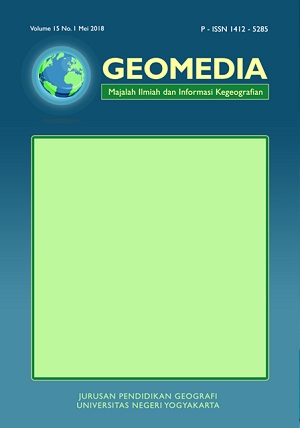Analisis Sebaran Tingkat Kerentanan Erosi di Kawasan DAS Alo, Gorontalo
DOI:
https://doi.org/10.21831/gm.v22i2.59553Keywords:
Erosion, ALO Watershead, USLEAbstract
References
Alfianto, A., Cecilia, S., & Ridwan, B. W. (2020). Pemodelan Potensi Erosi dan Sedimentasi Hulu Danau Limboto Dengan Watem/Sedem. Jurnal Teknik Hidraulik, 11(2), 67-82. doi:https://doi.org/10.32679/jth.v11i2.613
Eraku, S. S., & Permana, A. P. (2020). Analisis Kemampuan dan Kesesuaian Lahan Di Daerah Aliran Sungai Alo, Provinsi Gorontalo. Jukung (Jurnal Teknik Lingkungan), 6(1), 86-99. doi:http://dx.doi.org/10.20527/jukung.v6i1.8243
Halim, F. (2014). Pengaruh Hubungan Tata Guna Lahan Dengan Debit Banjir pada Daerah Aliran Sungai Malalayang. Jurnal Ilmiah Media Engineering, 4(1), 45-54. Diambil kembali dari https://ejournal.unsrat.ac.id/index.php/jime/article/view/4461
Hariyadi. (2016). Perkiraan Tingkat Bahaya Erosi Menggunakan Universal Soil Loss Equation (USLE) dan GIS Di Wilayah UPT PSDA Lumajang. Universitas Jember, Jurusan Teknik Pertanian. Jember: Repository Universitas Jember. Diambil kembali dari https://repository.unej.ac.id/handle/123456789/76495
Herawati, T. (2010). Analisis Spasial Tingkat Bahaya Erosi Di Wilayah DAS Cisadanekabupaten Bogor. Jurnal Penelitian Hutan dan Konservasi Alam (JPHKA), 7(4), 413-424. doi:https://doi.org/10.20886/jphka.2010.7.4.413-424
Jaya, R., & Rijal, A. S. (2020). Mapping of Landslide Hazard Distribution in Alo Watershed Gorontalo Regency. Jambura Geoscience Review, 2(1), 30-40. doi:https://doi.org/10.34312/jgeosrev.v2i1.2671
Jaya, R., Rijal, A. S., & Mohamad, I. R. (2020). Karakteristik Sosial Ekonomi Masyarakat Sub DAS Alo Terhadap Perilaku Pemanfaatan Fisik Lahan. Journal of Humanity & Social Justice, 2(1), 53-67. doi:https://doi.org/10.38026/journalhsj.v2i1.33
Lihawa, F. (2009). Pendekatan Geomorfologi Dalam Survei Kejadian Erosi. Jurnal Pelangi Ilmu, 2(5), 1-18. Diambil kembali dari https://ejurnal.ung.ac.id/index.php/JPI/article/view/586
Mooduto, W., Ayuba, S. R., Jaya, R., Tisen, Rijal, A. S., & Nursaputra, M. (2022, 3 30). Drought Index Determination Using the Batulayar Watershed Hydrology Model. Journal La Lifesci, 3(2), 54-64. doi:https://doi.org/10.37899/journallalifesci.v3i2.595
Rijal, A. S., Matalapu, I., Jaya, R., & Maulana, K. M. (2021). Analisis Mitigasi Bencana terhadap Kondisi Sosial Budaya di Gorontalo. LaGeografia, 19(2), 155-174. doi:https://doi.org/10.35580/lageografia.v19i2.17221
Saputro, E. S. (2009). Analisis Tingkat Bahaya Erosi (TBE) Pada Lahan Kering Tegalan di Kecamatan Tretep Kabupaten Temanggung. Semarang: UNNES Repository. Diambil kembali dari http://lib.unnes.ac.id/182/
Silalahi, R. R., Supriadi, S. S., & Razali, R. R. (2017). Pemetaan Tingkat Bahaya Erosi Sub DAS Petani Sumatera Utara. Jurnal Agroekoteknologi, 5(1), 185-193. Diambil kembali dari https://jurnal.usu.ac.id/index.php/agroekoteknologi/article/view/15111
Simanjuntak, H., Hendrayanto, & Puspaningsih, N. (2017). Calculation Methods of Topographic Factors Modification Using Data Digital Elevation Model (DEM) To Predict Erosion. Media Konservasi, 22(3), 242-251. doi:https://doi.org/10.29244/medkon.22.3.242-251
Downloads
Published
How to Cite
Issue
Section
Citation Check
License
Authors who publish in this journal agree to the following terms:
- Authors retain copyright and grant the journal the right of first publication with the work simultaneously licensed under a Creative Commons Attribution License that allows others to share the work with an acknowledgment of the work's authorship and initial publication in this journal.
- Authors are able to enter into separate, additional contractual arrangements for the non-exclusive distribution of the journal's published version of the work (e.g., post it to an institutional repository or publish it in a book), with an acknowledgment of its initial publication in this journal.
- Authors are permitted and encouraged to post their work online (e.g., in institutional repositories or on their website) prior to and during the submission process, as it can lead to productive exchanges, as well as earlier and greater citation of published work (See The Effect of Open Access).

Geo Media: Majalah Ilmiah dan Informasi Kegeografian is licensed under a Creative Commons Attribution-ShareAlike 4.0 International License.
Based on a work at https://journal.uny.ac.id/index.php/geomedia.







